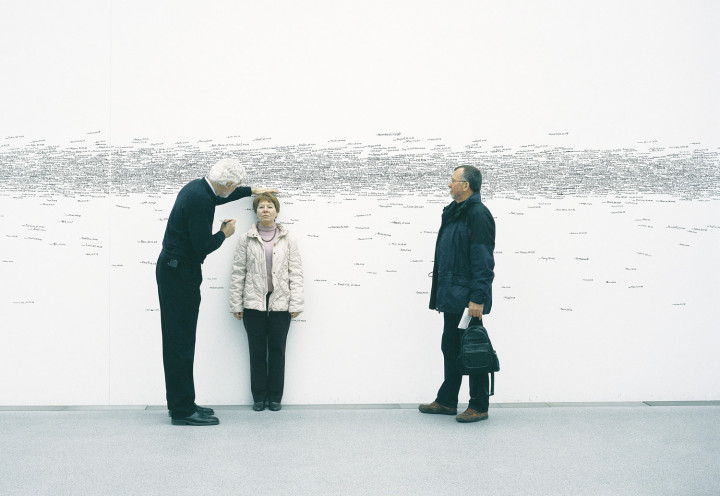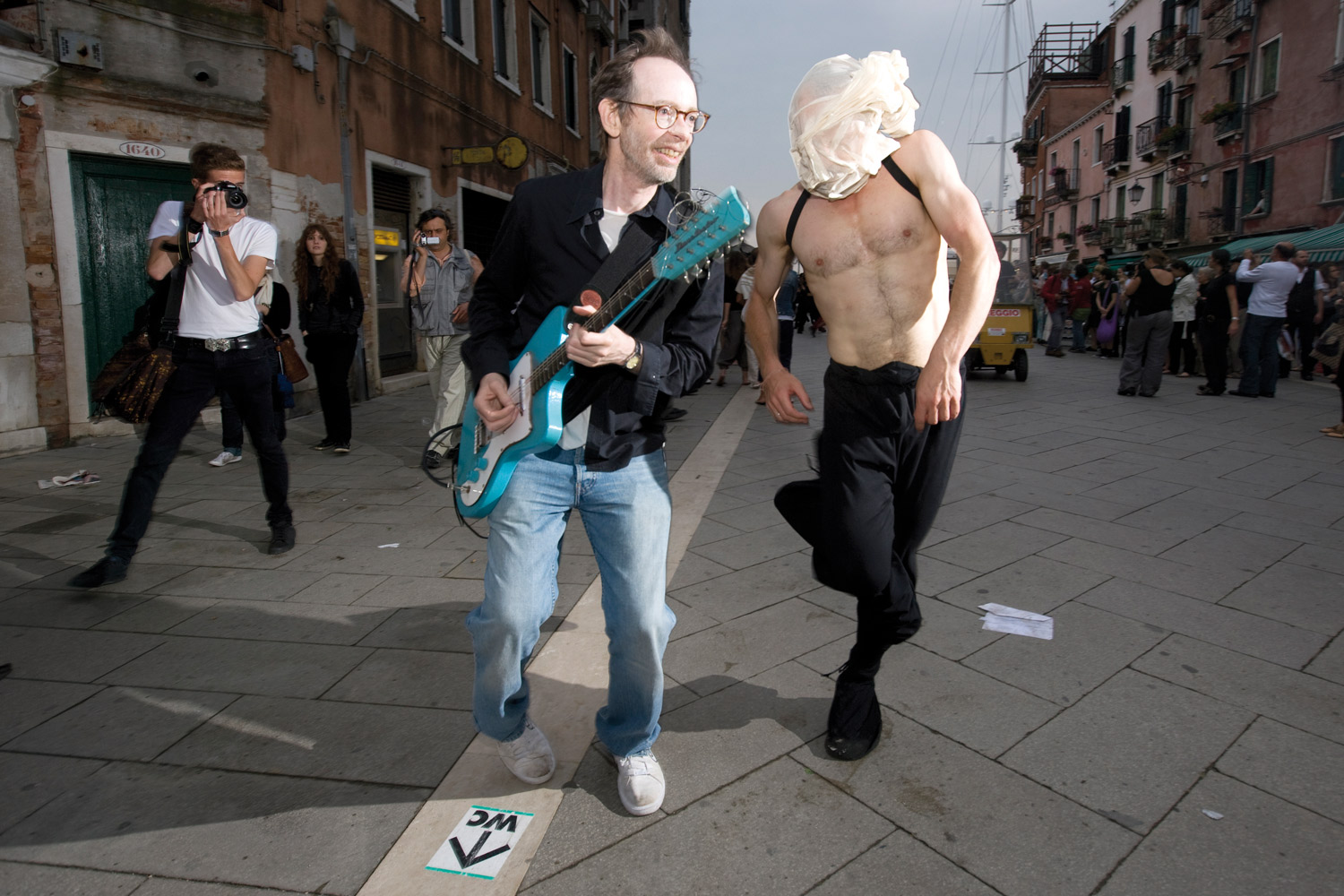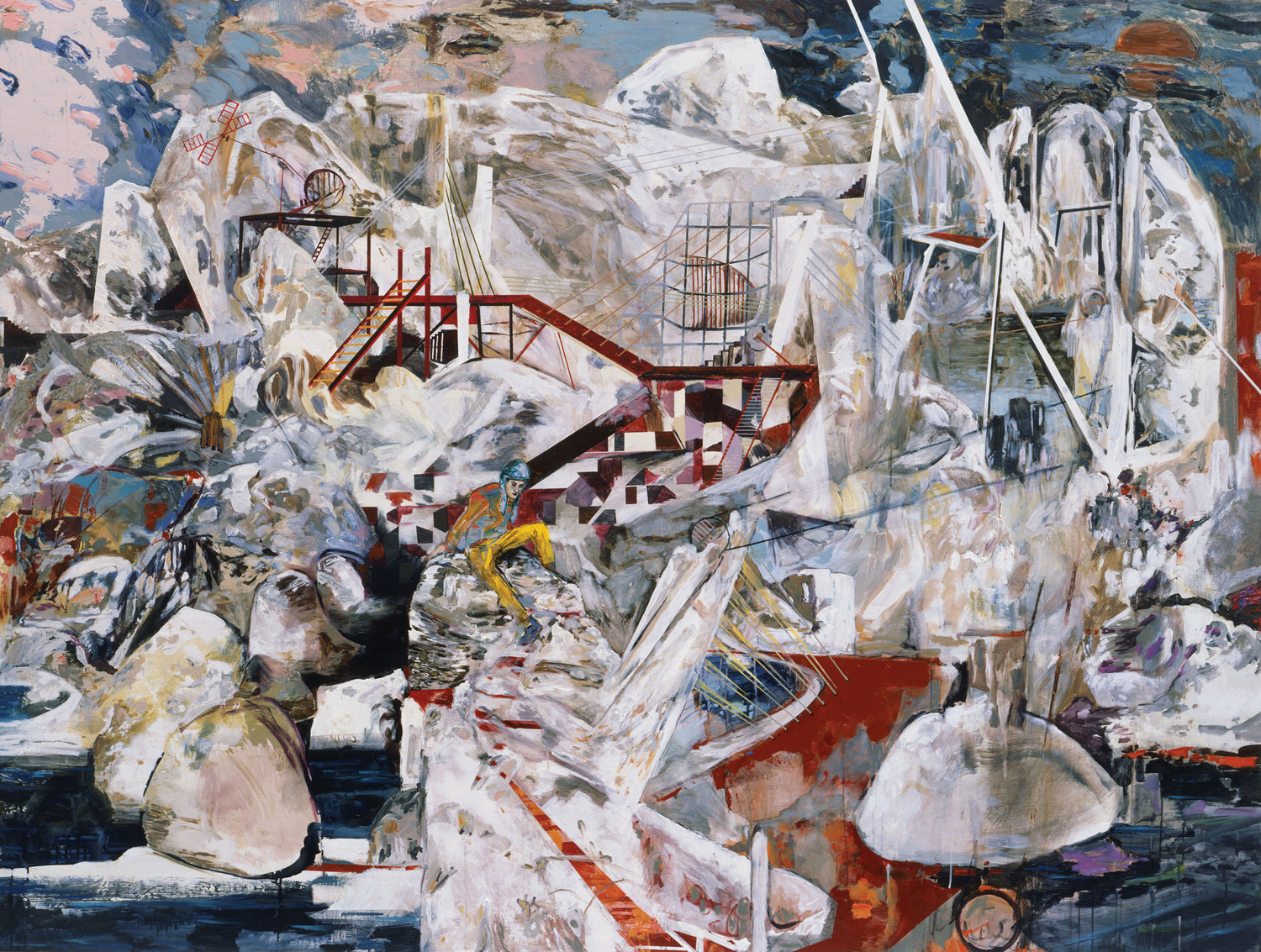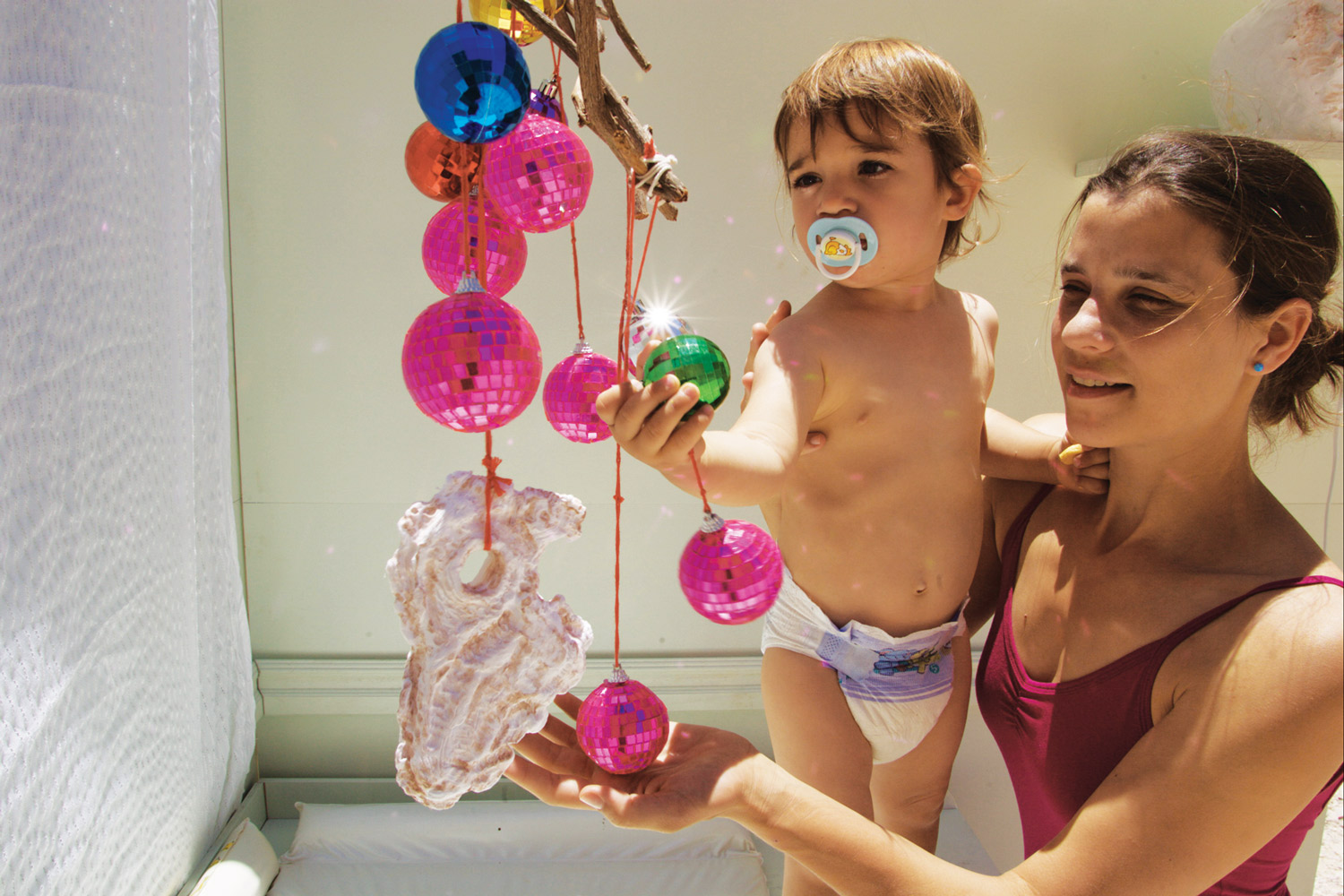
Klaus Biesenbach: Let’s start with your piece Measuring the Universe (2007) that we recently presented at MoMA. Does it start from the very first moment or after one or two weeks running, when it is more visible, when there are more traces on the wall?
Roman Ondák: It starts with the first measurement and ends when the last visitor gets measured. It resembles a clock, which indicates hours and minutes: any moment matters. So the performance has the same status with one mark on the wall as with thousands of them.
KB: MoMA had your piece for twelve weeks. On a sunny day the museum has five thousand people, and on a rainy day we have more than twenty thousand. Imagining that only half of the people on any given day are measured, I think this piece becomes nearly narrative — there’s an expectation of a climax. What was the longest run of this piece?
RO: I’m interested in observing what such a culmination of visitors can bring. The longest exhibition period was the first one, at the Pinakothek der Moderne in Munich, which was exactly as long as it is going to be at MoMA, three months, but the room was four times larger. Presumably they had a lot of visitors passing through the room in Munich, but of course it is not comparable to what can happen here in New York. At MoMA it can reach a total black stripe at a certain level. I’m rather curious to see the final result, as every new re-enactment of the piece brings an unpredictable end, depending on given architectural and cultural conditions.
KB: Your work is a bit like counting.
RO: It’s something like if I’d be sitting for the whole day in a café on the corner of a busy street, watching the crowd passing by, and I’d try to identify and remember everyone. Shifting this to a performance — which turns the domestic custom of recording children’s heights into a public event — I’m trying to visualize what this mass of people represents. The exhibition room, where measuring runs every day, functions a little bit like a container of the “here and now.” It shows there is an invisible potential to transform the presence of people into a physical object.
KB: At the very beginning Measuring the Universe was an empty gallery, which is very similar to More Silent Than Ever (2006), where there was a hidden eavesdropping device only signaled by a label on the wall. I don’t know whether it was there or not — I don’t care — but people were looking for it. I think that rather than a measurement, it was more like an “active observation” of the room. What is your ideal view of participation in that work?
RO: More Silent Than Ever plays with an expectation. And whether people are tempted to believe that there is an eavesdropping device concealed or not, they already participate by only thinking of it.

KB: My colleague Roxana Marcoci — who had to leave Romania when she was seventeen, going through a lot of interrogations by the secret service — immediately connoted this work as one by an artist born in the former Eastern block, because of the idea of a suspicion that there’s a microphone somewhere. You were quite careful to acknowledge it; is that something you want to stay away from in the work?
RO: The similar events that happened in the past in my country were the inspiration. I’ve never been interrogated, I was too young, but this is something I would read that way, since I still live in a country that is in constant transition, from the Communist regime to the so-called democratic system. We still witness daily a lot of situations that are full of doubts. I’m not ignoring them, although I’m trying to escape from the constraints of those references, so I’m filtering them. Some months ago I was in a show called “Vides (Voids): A Retrospective” at the Centre Pompidou. There were ten completely empty rooms, starting with The Specialization of Sensibility in the Raw Material State of Stabilized Pictorial Sensibility (1958) by Yves Klein; More Silent Than Ever from 2006 was the most recent one. Ten empty rooms with totally different origins but, when confronted with each other, looking similarly. Their backgrounds made them different. It was a good experience to understand more about whether this work is only about an empty room, as it looks, or whether it says something about my background.
KB: Marina Abramović, who spent her first thirty years of her life in former Yugoslavia, immediately associated your work that often features lines standing basically in front of nothing — outside or inside a museum — to the lines of people waiting in former Communist countries. In the very beginning I did not associate your work with Eastern systems but instead with the libidinousness of waiting for something that’s very rare. At MoMA we always have lines of people and we are always trying to avoid lines in the museum, so what you did was a sort of a “nightmare.” For example, I hate when in Venice for the Biennale there is a piece where only three people are allowed in. And throughout the Giardini there’s always a line, whether for the German Pavilion or for the British Pavilion. What about your Pavilion?
RO: Good Feelings in Good Times (2003), the queue piece that Marina and you were talking about, bears the ambiguity of how it can be perceived. There are references to my own memories on queues from my childhood, and at the same time the work shows full flexibility to adapt to any new environment by appropriating the social and cultural meanings from that particular environment where it is shown. For my piece Loop (2009), the point of departure was the pavilion itself, the nomination I received. I already had this idea of a work in which the real and represented would absolutely merge into one, but I tried to find the right moment and place to execute it. This nomination was a fact that didn’t at first make me happy, if I can say so, because I was aware of the struggle that comes out when you are representing something or somebody, which I’m always trying to escape from. But Loop seemed to be an ideal proposal for me to stay independent, while not to show independency for only my sake, but for the sake of the art form I had tried to develop. And there was also the tension in the pavilion itself, which is the legacy of former Czechoslovakia, split in 1993 between the Czech Republic and Slovakia, and consequently inheriting many complications. I was the first Slovakian artist to have the opportunity to show there alone; therefore it was a good challenge to take the pavilion as a whole, playing with its formal beauty as well as with its strong institutional background.

KB: I will describe what happened to me: I’m standing in front of the Venice Biennale Czech and Slovak Pavilion; there are no doors, they have been removed. I walk through and I somehow get distracted, and I suddenly find myself out of the pavilion… something happened to me, like walking from one pavilion to the other without being in the one in between. So I turn around and I realize that the front door and the backdoor were removed, the gravel path inside was made all the way through the pavilion and there was exactly the same structure, same trees, same gardening that was outside in the Giardini, put inside the pavilion. There was no difference… That was my experience. What of my experience do you think was fitting your intentions?
RO: I expected this kind of experience of visitors as you had yourself. Something that would firstly cause a double-take, but when seen again would remain stronger in memory. Something that would also stay beyond the physicality of the object and would be constructed by visitors in their imagination. Reactions like yours, when visiting the pavilion, were in my mind when I was working on the piece.
KB: There’s one work of yours where a mother brings her one-year-old child into the gallery, teaching him how to walk, helping him to make his first steps. Here you are bringing a very intimate moment into the gallery. Is this work similarly invisible, like the pavilion?
RO: Teaching to Walk (2002) is probably even more invisible than any other project of mine. With Loop it shares a lot of similarities. When I showed it in 2002 for the first time, my interest was in exploring the possibilities of a concept of what it is like to be a visitor to a museum or gallery. I was interested in what roles could be attributed to performers who’d simulate those real visitors visiting the gallery. The mother and her one-year-old boy, whom she’d teach to walk, was one of those concepts. I wondered what would be perceived of such a situation by other people visiting the exhibition, whether they would even notice it.
KB: So people noticed.
RO: Yes, they mostly did. I wanted to make a small shift from “the outside,” bringing the mother and the child for a certain moment to the gallery, letting them be there as much as they wanted, while she’d try to teach it to walk. Sometimes it was for twenty minutes, sometimes for one hour. The behavior of a child of this age is truly unpredictable, so the fate of the performance is partially also in its hands, not only in the mother’s.





